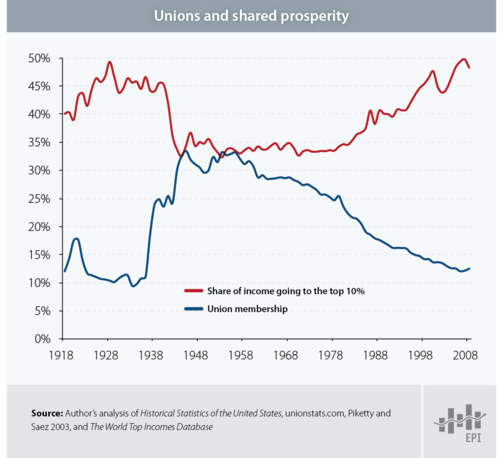Recent searches
Search options
Following from my last thread on unions and wages, I wanted to address that other capitalist shibboleth, the minimum wage.
AS EVERYONE KNOWS, prices are set by the market. When the state sets a wage by fiat that is higher than the equilibrium price, firms can’t afford to hire as many workers as they had previously intended. This creates both unemployment among the least productive, lowest paid workers, but also reduces the productivity of all those firms—ie, deadweight loss.
The real minimum wage, as I’m sure you all know, is $0.00. That is, there is some poor benighted or desperate fool willing to work for literally any price N, and some firm might be willing to employ them at that price as long as the worker can produce N + $0.01 worth of value for the firm. But minimum wage law sets those wages arbitrarily high, and firms can’t afford to hire and pay this worker if that wage is higher than N.
This is all VERY BAD.
1/
But something strange happens when governments set minimum wages: employment tends not to decrease. Sometimes, it even increases! This is from The Economist, that stalwart capitalist rag:
“The empirical study which revitalised the debate on minimum wages in the 1990s was by David Card and Alan Krueger, both then at Princeton University. In 1992 New Jersey increased its hourly wage floor from $4.25 to $5.05. Neighbouring Pennsylvania kept its own at $4.25. Thrilled at the prospect of a naturally occurring case study, the two economists gathered information of employment at fast-food restaurants in both states before the April increase and again several months later. Fast food seemed to offer the ideal conditions for a study, as a homogenous sector employing unskilled workers.
The increase in the wage floor did not lead to jobs being lost in New Jersey; employment in the restaurants they looked at went up. Nor did the authors find any indication that the opening of future restaurants would be affected. Looking at the growth in the number of McDonald’s restaurants across America, they saw no tendency for fewer to open where minimum wages were higher.”
http://reparti.free.fr/sminharm820.pdf
2/
Why might this be? Why might employment stay the same or even increase when the state legislates a minimum wage, theoretically raising the price of the lowest-cost labor?
We might consider that the statutory minimum wage is not an artificial floor, but is already actually *lower* than it would otherwise be.
Let’s take a look at Denmark. In Denmark, there is no statutory minimum wage. Despite this, Danish workers earn no less than the effective minimum wage of $16-18 per hour. This is much higher than the statutory minimum wage in the US of $7.25. Capitalist ideologues promised me this was impossible—in the absence of a statutory wage floor, there would be workers employed at literally every wage, including as little as $0.01.
And yet, there it is.
3/
One major difference between these two labor markets that could explain this discrepancy is in their differing levels of labor organization. In Denmark, about 70% of workers belong to labor unions, which are so large that they can bargain not just with individual firms but *sectorally,* setting wages and working conditions for entire sectors of the economy at a time.
In contrast, only about 11% of US workers are unionized—and only about 6% of private sector workers, down from about 35% during the 1930s. As I discussed last time, divided and atomized workers, forced to bargain one-by-one, lack the power to negotiate for wages that their unionized peers do.
We could imagine US workers unionized at the same rate as their Danish counterparts and collectively bargaining for an *effective* minimum wage that is dramatically higher than their *statutory* minimum wage. Maybe the lowest collectively bargained wage would be $16 or $18 or even higher.
4/
But US workers can’t organize freely the same way that Danish workers can, despite the pretenses to freedom of association. The US has mostly moved on from the practice of outright murdering union organizers and deploying the army to attack striking workers, but that doesn’t mean there isn’t still a legal regime that is immensely hostile towards organizing themselves.
From the Taft-Hartley Act in 1947—which outlaws all sorts of strikes and lets states ban union shops—to Janus v. AFSCME in 2018–which blocks unions from entering into exclusive supplier contracts with firms—the US legal apparatus is deeply, profoundly hostile to labor organizing. (This legal regime makes a mockery of the idea that Americans enjoy a “free” market, so to maintain the friction, ideologues are employed to convince everyone that labor unions are little cartels rather than the simple equivalent of labor-selling firms.)
Add on top of that the enormous (and often formally illegal) efforts by private firms to prevent the formation of unions, and we see how labor unions could represent such a small number of US workers despite the large and growing popularity of union organizing.
5/
We can thus reconcile minimum wage laws with no increase in unemployment by understanding that wages in the US are artificially low, by capitalists’ own standards.
Rather than letting workers and firms freely bargain with each other, which in a free market would include labor organizing to create collective bargaining power, the state massively intervenes to distort the market. The result is a wage level far below any kind of idealized equilibrium price, even setting aside all of the violence the state performs to create capitalism in the first place.
So when the state sets minimum wages by law, it is not creating an artificial floor below which wages would otherwise naturally fall. It is setting a ceiling on the amount that employers are allowed to exploit from workers prohibited from freely associating. Using the Danish example, we might calculate that this surplus that employers legally extract from workers amounts to tens of thousands of dollars each year for every full-time worker employer at the federal minimum wage of $7.25 per hour.
6/
Firms can pay that statutory minimum wage without losing employment because they’re not losing any money off those employees—they’re extracting all that money *on top of* whatever value the employee would be generating if paid $16-18 per hour.
All that money constitutes a massive subsidy by employees to employers, enforced by the state, in a titanic distortion of the “free” market. Hypothetically, even taking at face value all the tropes of capitalist ideology, we could raise minimum wages to the Danish level with no impact on employment.
Of course, all of capitalism is predicated on massive state violence to immiserate people and transform them into a proletariat with no choice but to labor for wages, a titanic subsidy to capitalists that eliminates the possibility of there being a “fair” wage at all. But even ignoring all this and pretending that wages are set by market forces, we find that minimum wage laws are a a marginally corrective bandaid on the primary distortion.
7/end
PS: if you enjoy my writing, you can always support me by buying me a coffee here:



